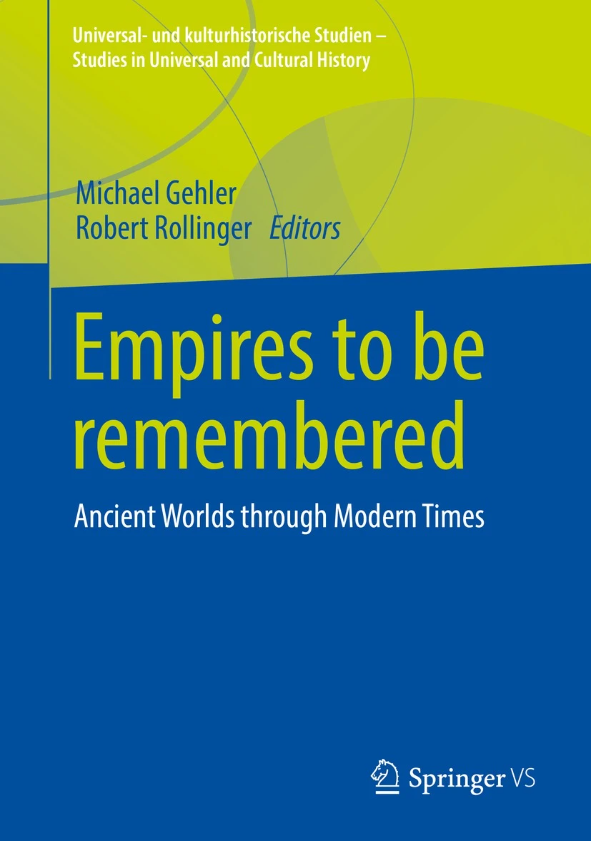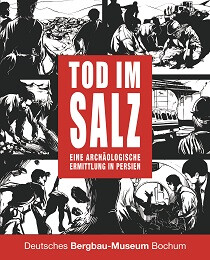Publications so far
0
| 1. |  | Labisi, Guiseppe: Squinches and Semi-domes Between the Late Sasanian and Early Islamic Periods. In: Iran: Journal of the British Institute of Persian Studies, iss. 28, no. 2, pp. 236-49, 2022. (Type: Journal Article | Abstract | Links | BibTeX)@article{nokey,The aim of this paper is to present a first attempt at a comprehensive classification of squinches related to semi-domes, in Persian kāna pūsh, in Greater Syria, Mesopotamia and Iran between the late Sasanian and early Islamic periods. This feature is a characteristic of the Persian architectural tradition: all the preserved examples are in buildings of considerable importance (most are related to the architecture of the élites) and demonstrate a typological evolution. Furthermore, their origin can also be backdated to between the late Sasanian and early Islamic periods. |
| 2. |  | Hoffmann, Birgitt: The Mongol Ilkhanate of Iran: Realm or Empire?. In: Gehler, Michael; Rollinger, Robert (Ed.): Empires to be Remembered. Ancient World through Modern Times, pp. 355-365, Springer, Wiesbaden, 2022, ISSN: 2524-3780. (Type: Book Chapter | Links | BibTeX)@inbook{nokey, |
| 3. |  | Djamali, Morteza; Rashidian, Elnaz; Capano, Manuela; Askari-Chaverdi, Alireza; Faucherre, Nicolas; Guibal, Frédéric; Northedge, Alastair; Tuna, Thibaut; Bard, Edouard: An Absolute Radiocarbon Chronology for the World Heritage Site of Sarvestan (SW Iran): A Late Sasanian Heritage in Early Islamic Era. In: Archaeometry, iss. 64, no. 2, pp. 545–59, 2021. (Type: Journal Article | Abstract | Links | BibTeX)@article{nokey,This study presents a new precise radiocarbon chronology for the World Heritage site of Sarvestan (SW Iran). The monument is a key construction in the history of architecture because it is a typical Sasanian construction built during the late Sasanian or early Islamic period. Previous attempts to date the monument have suggested the ages ranging from the middle Sasanian (fifth century CE) to early Abbasid (ninth century CE) era. These age estimations are based on the analysis of architectural plans and techniques, and a few radiocarbon dates with very large age uncertainties. This paper presents the results of a systematic radiocarbon dating of timbers in the walls and charcoals in plaster mortars used in the main dome of the monument. It further applies wiggle matching technique and R_Combine function to substantially reduce the age uncertainties in wood sections. The results indicate that a major construction work was undertaken sometime between 658 and 683 CE, the century of the invasion of Fars by Muslim Arabs. This finding pushes back the age of Sarvestan for two centuries and suggests that the monument was built at the transitional period between Sasanian to Islamic era. Sarvestan would have been an architectural project designed and possibly initiated during the late Sasanian period but mainly accomplished during the second half of the seventh century CE. It can thus be considered a late Sasanian heritage in early Islamic period. Its construction at a time of political unrest further suggests that some areas of Fars may have benefited from certain socio-political stabilities during the expansion of Islam into the east at mid- to late seventh century CE. |
| 4. |  | Stöllner, Thomas; Aali, Abolfazl: Long-Term Salt Mining in Chehrābād: Resilient Strategies in Accessing Mineral Resources at the Iranian Highlands. In: Pearls, Politics and Pistachios: Essays in Anthropology and Memories on the Occasion of Susan Pollock’s 65th Birthday, pp. 352-369, Ex Oriente/Propylaeum, Berlin/Heidelberg, 2021. (Type: Book Chapter | Links | BibTeX)@inbook{nokey, |
| 5. |  | Stöllner, Thomas; Aali, Abolfazl; Kashani, Natascha Bagherpour (Ed.): Tod im Salz. Eine archäologische Ermittlung in Persien. Nünnerich-Asmus Verlag & Media GmbH, 2020, ISBN: 978-3-96176-141-8. (Type: Book | Abstract | Links | BibTeX)@book{nokey,Since the first discoveries in 1993 bodies or body-parts of eight humans have been discovered at the salt-mine of Douzlākh at Chehrābād. These bodies allow a reconstruction of their lives as workers during the different operation periods. By involving many different scientific fields, it became possible to investigate their palaeo-medical aspects, their diet and their health status as well the causes of their death and their involvement into different aspects of the mining operation and logistics of the mine. It is possible not only to reconstruct three different catastrophes during the Achaemenid, the early and the late Sasanian times but also to understand the social aspects of the working people. The Achaemenid miners certainly came from abroad but already stayed a while in the region, apart from the young miner no. 4 who seems to have arrived shortly before the catastrophe. This group of migrants possibly were sent within a “bandaka”, an Achaemenid labour duty. The Sassanian miners partly came from a “regional” background but also came shortly before their deaths. Saltman 1 is interesting as he is an older individual who possibly had a special role within the miners. Mining at Douzlakh was predominantly operated in periods of strong centralized political systems when governmental activities could be organized over longer distances. |
| 6. |  | Melikian-Chirvani, Assadullah Souren: The White Bronzes of Early Islamic Iran. In: Metropolitan Museum Journal, vol. 9, pp. 123-151, 1974. (Type: Journal Article | Links | BibTeX)@article{nokey, |
2022 |
|
 | Labisi, Guiseppe: Squinches and Semi-domes Between the Late Sasanian and Early Islamic Periods. In: Iran: Journal of the British Institute of Persian Studies, iss. 28, no. 2, pp. 236-49, 2022. (Type: Journal Article | Abstract | Links | BibTeX | Tags: Architecture, Islamic era, Sasanian, Social, social relations, Syria)@article{nokey,The aim of this paper is to present a first attempt at a comprehensive classification of squinches related to semi-domes, in Persian kāna pūsh, in Greater Syria, Mesopotamia and Iran between the late Sasanian and early Islamic periods. This feature is a characteristic of the Persian architectural tradition: all the preserved examples are in buildings of considerable importance (most are related to the architecture of the élites) and demonstrate a typological evolution. Furthermore, their origin can also be backdated to between the late Sasanian and early Islamic periods. |
 | Hoffmann, Birgitt: The Mongol Ilkhanate of Iran: Realm or Empire?. In: Gehler, Michael; Rollinger, Robert (Ed.): Empires to be Remembered. Ancient World through Modern Times, pp. 355-365, Springer, Wiesbaden, 2022, ISSN: 2524-3780. (Type: Book Chapter | Links | BibTeX | Tags: Ilkhanate, Islamic era, Mongols)@inbook{nokey, |
2021 |
|
 | Djamali, Morteza; Rashidian, Elnaz; Capano, Manuela; Askari-Chaverdi, Alireza; Faucherre, Nicolas; Guibal, Frédéric; Northedge, Alastair; Tuna, Thibaut; Bard, Edouard: An Absolute Radiocarbon Chronology for the World Heritage Site of Sarvestan (SW Iran): A Late Sasanian Heritage in Early Islamic Era. In: Archaeometry, iss. 64, no. 2, pp. 545–59, 2021. (Type: Journal Article | Abstract | Links | BibTeX | Tags: Dating, Islamic era, Sasanian)@article{nokey,This study presents a new precise radiocarbon chronology for the World Heritage site of Sarvestan (SW Iran). The monument is a key construction in the history of architecture because it is a typical Sasanian construction built during the late Sasanian or early Islamic period. Previous attempts to date the monument have suggested the ages ranging from the middle Sasanian (fifth century CE) to early Abbasid (ninth century CE) era. These age estimations are based on the analysis of architectural plans and techniques, and a few radiocarbon dates with very large age uncertainties. This paper presents the results of a systematic radiocarbon dating of timbers in the walls and charcoals in plaster mortars used in the main dome of the monument. It further applies wiggle matching technique and R_Combine function to substantially reduce the age uncertainties in wood sections. The results indicate that a major construction work was undertaken sometime between 658 and 683 CE, the century of the invasion of Fars by Muslim Arabs. This finding pushes back the age of Sarvestan for two centuries and suggests that the monument was built at the transitional period between Sasanian to Islamic era. Sarvestan would have been an architectural project designed and possibly initiated during the late Sasanian period but mainly accomplished during the second half of the seventh century CE. It can thus be considered a late Sasanian heritage in early Islamic period. Its construction at a time of political unrest further suggests that some areas of Fars may have benefited from certain socio-political stabilities during the expansion of Islam into the east at mid- to late seventh century CE. |
 | Stöllner, Thomas; Aali, Abolfazl: Long-Term Salt Mining in Chehrābād: Resilient Strategies in Accessing Mineral Resources at the Iranian Highlands. In: Pearls, Politics and Pistachios: Essays in Anthropology and Memories on the Occasion of Susan Pollock’s 65th Birthday, pp. 352-369, Ex Oriente/Propylaeum, Berlin/Heidelberg, 2021. (Type: Book Chapter | Links | BibTeX | Tags: Achaemenid, Administration, Bronze Age, Chalcolithic, Institutions, Iron Age, Islamic era, Minerals, Mining, Neolithic, Resilience, Resources, Salt, Sasanian, Zanjan)@inbook{nokey, |
2020 |
|
 | Stöllner, Thomas; Aali, Abolfazl; Kashani, Natascha Bagherpour (Ed.): Tod im Salz. Eine archäologische Ermittlung in Persien. Nünnerich-Asmus Verlag & Media GmbH, 2020, ISBN: 978-3-96176-141-8. (Type: Book | Abstract | Links | BibTeX | Tags: Achaemenid, Administration, Bronze Age, Chalcolithic, Institutions, Iron Age, Islamic era, Minerals, Mining, Mobility, Neolithic, Salt, Sasanian, Zanjan)@book{nokey,Since the first discoveries in 1993 bodies or body-parts of eight humans have been discovered at the salt-mine of Douzlākh at Chehrābād. These bodies allow a reconstruction of their lives as workers during the different operation periods. By involving many different scientific fields, it became possible to investigate their palaeo-medical aspects, their diet and their health status as well the causes of their death and their involvement into different aspects of the mining operation and logistics of the mine. It is possible not only to reconstruct three different catastrophes during the Achaemenid, the early and the late Sasanian times but also to understand the social aspects of the working people. The Achaemenid miners certainly came from abroad but already stayed a while in the region, apart from the young miner no. 4 who seems to have arrived shortly before the catastrophe. This group of migrants possibly were sent within a “bandaka”, an Achaemenid labour duty. The Sassanian miners partly came from a “regional” background but also came shortly before their deaths. Saltman 1 is interesting as he is an older individual who possibly had a special role within the miners. Mining at Douzlakh was predominantly operated in periods of strong centralized political systems when governmental activities could be organized over longer distances. |
1974 |
|
 | Melikian-Chirvani, Assadullah Souren: The White Bronzes of Early Islamic Iran. In: Metropolitan Museum Journal, vol. 9, pp. 123-151, 1974. (Type: Journal Article | Links | BibTeX | Tags: Archaeometallurgy, Bronze, Islamic era)@article{nokey, |
